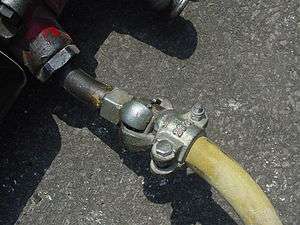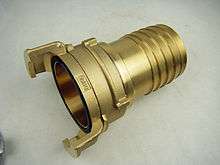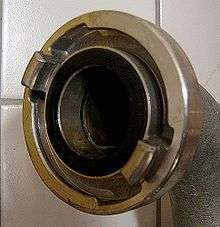Hose coupling

A hose coupling is a connector on the end of a hose to connect (or couple) it with another hose or with a tap or a hose appliance, such as an irrigation sprinkler. It is usually made of steel, brass, stainless steel, aluminium or plastic.
Types
Air King
The "Air King"[1] universal air hose coupling, also known as a "Chicago style" fitting, is malleable iron or brass "quarter turn" "sexless coupling" usually found on large pneumatic tools like jackhammers.[2] The fitting is considered "universal", because a common two-lug head is used on all sizes ranging from 0.25 to 1 inch (6 to 25 mm).

Barcelona
This coupling is used by Spanish firefighters. It is a sexless coupling with three engaging lugs.
Cam and groove
A cam and groove is a quick connect fluid transfer hose coupling that consists of a male "adapter" and female "coupler". The adapter has a groove on the outside that is engaged by the "cam arms" on the outside of the coupler to effect a seal against the gasket inside the "coupler". They are commonly used for petroleum or chemical applications.
Expansion ring
An expansion ring fire hose coupling is commonly used on lay-flat fire hose.[3] It has the advantage of providing no flow restriction, as the expansion ring is expanded to match the inner diameter of the hose. It is installed with special machinery using a drawbar expander. In the United States, it is most commonly supplied with NST (NH) threads.
Express coupling
This is kind of symmetrical half coupling for water and air use. The most popular standard is NF E 29-573.
Operation of this kind of coupling is pushed two couplings and rotate close into a seal form. It is popular in France area and European market with brass and stainless steel.
Garden hose thread
See Garden hose thread. See also Hozelock plastic click-on connectors.
Gost
A sexless coupling used on fire hoses in Russia.
Ground joint
A "boss" ground joint coupling valve hose coupling, primarily used for compressed air or steam. It consists of a stem, wing nut and spud. It seals as a soft copper seat located in the spud is drawn against the stem by tightening the wing nut.
Guillemin symmetrical clutch

The Guillemin symmetrical clutch, also called Guillemin coupling, is widely used in France and in Belgium to couple hoses and resembles a DSP coupling, which is used in firefighting. It can be fastened by hand, but it is also possible to use a tricoise wrench. It has quarter-turn closing and is sexless (symmetrical). It may be fabricated from aluminum, stainless steel, brass or polypropylene. The standard for this kind of coupling is EN14420-8/NF E 29-572, and there is a kind of special standard DIN14420-8 for unique assemblies with ferrule and safety clamp.
Holedall
Mulconroy
Mulconroy/Holedall swaged hose coupling is commonly found on larger diameter hoses used in higher pressure applications or where the hose is exposed to higher end pull, e.g., Oil Suction & Discharge (OS&D) hose).[2] They are installed with special hydraulic ram machinery and special dies.
Holedall IX
Holedall IX internally expanded (internally swaged) hose coupling is used in higher pressure applications, or where the hose is exposed to higher end pull, or where a full flow is required.[2] They are installed with special hydraulic drawbar machinery, using special pull plugs.
Scovill/Rostra
Holedall (Scovill/Rostra) internally expanded hose coupling is used primarily on fuel oil hose applications, where a full flow is required.[2] They are installed with special hydraulic drawbar machinery, using special pull plugs.
Hoselink
A bayonet garden hose connection with an o-ring to o-ring seal designed and patented in 1998.[4] It is popular in Australia, with limited distribution in the UK and the US.
Hozelock
Around 1955 Hozelock Ltd in the United Kingdom invented and patented the international standard plastic, click-on style, push-fit hose end connector now used with garden hoses. The concept was developed to replace metal hose end connectors in coal mines, which were prone to cause static sparks and the possibility of methane gas explosions. The system is now universally used by gardeners throughout the world.
Machino
A quick connect and disconnect coupling used on fire hoses in Japan.
Nakajima
A quarter-turn, sexless coupling used on fire hoses in Japan.
NST
National Standard Thread (NST), also known as National Hose thread (NH). It is the most common type of fire hose coupling used in the United States. The male and female straight (non-tapered) threads screw together and the connection is sealed with a gasket.
Storz

A Storz coupling is a quarter-turn or sexless coupling, commonly used to connect to fire hydrants. It is easy to connect, has no particular male or female end, and lugs are on the inside of the joint. This is the standard coupling on fire hoses in Denmark, Germany, Austria, Switzerland, Sweden, the Netherlands and Greece.[5] It is also widely used in Australia. It can be manufactured by casting for general hose connection and low pressure applications, but for firefighting, it is better to use forgings to guarantee the safety and durability of the coupling.
Tri-Clover
A sexless sanitary connection system, used with a gasket and clamp; found in the wine and beer brewing industries.
Wakesha Cherry-Burrel
A sexed sanitary connection system, used with a gasket and clamp; found in the wine and beer brewing industries.
See also
- AN thread
- Gladhand connector — used on railroad car brake systems
- Glossary of firefighting equipment
- Hose barb
- Hose clamp
- Jubilee Clip
References
- ↑ Air King
- 1 2 3 4 Distributed by Dixon Valve & Coupling Company in the United States, http://www.dixonvalve.com/
- ↑ Manufactured by Red Head Brass LLC in the United States, http://www.redheadbrass.com/
- ↑ "Hose coupling by Hoselink Pty. Limited – AU 1998066040". www.ipaustralia.com.au. Retrieved 2016-04-04.
- ↑ T.O.T.E.E. 2451/86 Εγκαταστάσεις σε κτήρια: Μόνιμα πυροσβεστικά συστήματα με νερό, Technical Chamber of Greece, 1986, pp. 12, 15, 20.